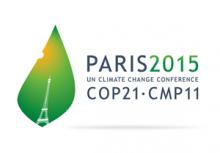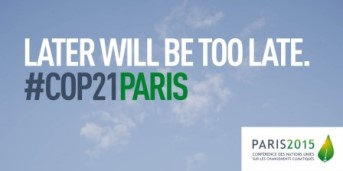Welcome to the
Run on Sun Monthly Newsletter

December, 2015
Volume: 6 Issue: 12
World Leaders Talk Climate Solutions — Solar Stands OutFrom November 30 to December 11, representatives from more than 190 countries came together to reach agreement on global climate efforts at the United Nations Conference of Parties (COP21) in Paris.
The key takeaway in their synthesis: Scientists are now more certain than ever that climate change is real; it's caused by human activities, especially the burning of fossil fuels; and it's already impacting people around the world, from rising sea levels to more extreme weather events. Hence the overarching goal in Paris was to frame a deal to prevent Earth from warming above the point of no return (more than 2°C). In the months leading to the conference nearly every country on the planet submitted their commitments to reduce greenhouse gases based on the IPCC report, called Intended Nationally Determined Contributions (INDCs). The United States' INDC outlines a commitment to cut emissions by 26-28% below 2005 levels by 2025, mostly by reducing CO2 emissions from coal-fired power plants. All 156 INDCs, representing 97.8% of global emitters, were plugged into the final document crafted through the high level negotiations. The COP21 final accord will actually be divided into a "core agreement," laying out the broad objectives for emissions reduction and how to pay for poor nations' efforts, and "decisions" describing how these objectives will be achieved. While the commitments to cut emissions by the world's countries is a great start, without legally binding targets and accountability, these promises hold little weight. It will also be interesting to see if, and how, leaders will establish a path forward with plans to reconvene and re-affirm their targets regularly. Will the Paris accord stop climate change?The unfortunate reality is that even if every country followed through with their commitments, scientists estimate that global warming will be about 2.7 degrees Celsius above pre-industrial levels. Given that a 2 degree increase is the limit necessary to avert the worst impacts, we will still need to focus on adaptation as well as mitigation to climate change. But on the bright side, it's a lot less warming than would happen if we continue the status quo without curbing any emissions at all! This summit isn't the end of the fight to limit climate change. But considering there has never before been international agreement on climate efforts - the Kyoto Treaty never got off the ground, due in large part to the failure of the US to join - it is a huge step to come together in the battle. As technologies such as solar improve and countries become more confident in their ability to transition to cleaner energy, they can step up their action over time.
According to research by the World Resources Institute, if Brazil, China, the EU, India, Indonesia, Japan, Mexico, and the United States follow through on their commitments, the amount of clean energy installed will more than double by 2030! The US targets were largely based on the projected outcome of President Obama's Clean Power Plan, which limits greenhouse gas emissions from coal plants and aims to get 20% of electricity from renewables by 2030. The Clean Power Plan has yet to be approved by the Senate and has significant opposition. One can hope that the COP21 and international pressure to act will help on this front. But in a climate where federal tax credits are under threat and state-level clean energy incentives are rapidly drying up, the US commitments on an international stage could be an important backstop to helping the renewable energy sector grow. On a final note, we at Run on Sun are thrilled about the events in Paris. As the international community finally comes together to tackle climate change our optimism about the world's ability to act meaningfully is renewed! However, the work that must be done doesn't end there. Next week, next month, next year and on and on the fight will continue. Governments, the private sector, and even individuals must continue to act every day on behalf of the only planet we've got. Going solar is one of the best ways to reduce your emissions impact from your home or business. We look forward to doing our part! |
“Scientists are now more certain than ever that climate change is real; it's caused by human activities, especially the burning of fossil fuels; and it's already impacting people around the world…”
Get your copy of
Commercial Solar:
Step-by-Step
from
Run on Sun
Founder & CEO
Jim Jenal

Now available on Amazon.com
in both
Print & Kindle versions.
Bonus - Buy the Print version…
Get the
Kindle version for Free!
Commercial Solar:
Step-by-Step
from Run on Sun
Founder & CEO
Jim Jenal

Now available on Amazon.com
in both Print & Kindle versions.
Get the Kindle version for Free!
Help Us Spread the News!


We use Angie's List to assess whether we're doing a good job keeping valued customers happy. Please visit AngiesList.com in order to grade our quality of work and customer service.
Happy Holidays! |
Top 5 Reasons Solar Soared in 2015!There can be no doubt, 2015 was an amazing year for solar. As we reach the end of the year, here's our look back on the top five reasons solar soared in 2015! 5. Run on Sun had its Best Year Ever!
We can't wait to meet and exceed our success this past year in the New Year ahead! 4. Politicians that Got It!Political leadership on dealing with Climate Change was finally in evidence this year, and the resultant policies are, inevitably, pro-solar. Exhibit A was California Governor Jerry Brown pledging to have the state generate 50% of its electricity from renewable sources by 2030, a mere fifteen years away! Said the Governor:
We are on board with that! But political leadership extended far beyond the borders of our great state in 2015! More than 190 countries came together in Paris to agree to the most far-reaching accord ever to address Climate Change, and lots more solar was high on their list of ways to achieve a more sustainable planet. To be sure, none of these actions were without their political opponents, but it is impossible to deny that 2015 marked a major turning point in the public's perception of the need to act, and those views were increasingly adopted by the world's politicians. 3. Smart Energy Storage (Finally) Comes of Age (Almost)!Ok, we have to give the man his due — Elon Musk's outlandish PowerWall announcement changed the conversation around smart energy storage (and our blog post debunking his most outrageous claims became our most viewed post of the year!). Indeed, storage went from being a topic hardly ever mentioned by a potential client, to something that nearly everyone did after Elon did his thing. Unfortunately, the hype still leads the market, and mature products are still not really available. But that is changing rapidly, and from our perspective that can't happen soon enough. 2. Net Metering 2.0 Saves Solar in California — We Hope!There had been great angst in the solar community about the future of net metering — the means by which solar owners get compensated for excess energy that they put out onto the grid — in California (and elsewhere). Decisions about net metering in other states that bent over backwards to appease utility demands only ratcheted up the anxiety in California as the state's Public Utilities Commission deliberated over competing proposals for Net Metering 2.0 - including utility schemes that could have gutted the market for solar. Fortunately our fears were not realized and the preliminary decision — due to be made final in January — was quite solar friendly. Once we have a final decision we will report on it in depth, but for now this looks like one of the biggest pro-solar developments of 2015. 1. Federal Solar Investment Tax Credit is Extended!The number one, most amazing, and most amazingly unexpected development to boost solar in 2015 is unquestionably the major extension of the 30% federal solar investment tax credit (ITC).
Moreover, the "placed in service" language — which required a project to be commissioned before the credit could be claimed, thereby leaving installers and clients at the not-so-tender mercies of the local utility — was replaced by the far more manageable, "commenced construction" requirement. The net benefit of this will be a more orderly market, driven by rational purchasing decisions rather than a panicked stampede to meet an arbitrary deadline at the end of next year. And beyond that, keeping the ITC in place for many years to come will help to grow solar in ways that would not have been possible otherwise. The industry, the economy, and the environment were all winners here. So that's our wrap on 2015 — truly a great year for solar! But we are betting that 2016 — with your help, of course — will be even better! Watch this space! Happy New Year! |






